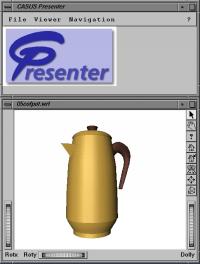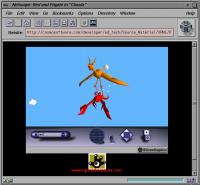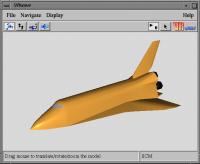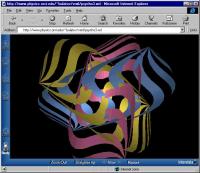
 |
||||
| Part One: A Guide to VRML 2.0 |       
|
A Web browser, such as Netscape Navigator or Microsoft Internet Explorer, can normally only display HTML text and images. In order to view and interact with a VRML 2.0 world, a special VRML browser program is required. The Web browser will automatically start an installed VRML browser when a .wrl file is loaded. A number of different VRML browsers are currently available for Windows, Macintosh and UNIX computer systems. This section will describe the main features of six different VRML 2.0 browsers: Fraunhofer Institute's CASUS Presenter, Sony's Community Place, Silicon Graphics' Cosmo Player, SIM's VRMLview, VRwave from IICM and Intervista's WorldView. All of which are available via the internet.
Plug-ins and Helper Applications
Most VRML browsers operate as a plug-in, where the 3D scene and user interface controls are actually displayed within the main Web browser window. This allows a VRML scene to be embedded within a HTML document (see Section 5.2 for more details). However, some VRML browsers display the VRML world independently of the Web browser. They need to be set up as a helper application in order to work in conjunction with the web browser.
Navigation and Interaction
VRML browsers usually offer the user more than one way of examining or moving through the VRML scene. Although the methods of interaction are implemented differently on each browser, they are typically based on examine, fly, walk and click-and-seek themes. In examine mode, the user can rotate an object or move it in relation to the viewpoint. A fly mode simulates moving through the scene, with mouse or keyboard input controlling speed and direction. Walk mode is similar to fly mode except the user's viewpoint will follow the terrain. Finally, some browsers implement a seek mode, where the user can click on a object with the mouse pointer and the viewpoint will move automatically towards it. VRML browsers also usually allow the user to switch between the viewpoints defined within the VRML file.
Two other features found in all VRML browsers are an optional "headlamp" to illuminate the scene immediately in front of the viewpoint and a method to allow the user to select an object, usually by clicking on it with the mouse pointer, in order to follow a hyperlink or to activate a sensor.
Fraunhofer Institute for Computer Graphics, Darmstadt, Germany (www.igd.fhg.de)
Current Version
CASUS Presenter 1.0a10 is available for SGI, Sun Solaris, Windows 95 and NT platforms. It is free for non-commercial use, but note that it also requires the Open Inventor run-time libraries to operate.

Figure 2-1 CASUS Presenter, model from Cosmo Software's Object Library Features
CASUS Presenter is a stand-alone helper application, developed to test Java animations within VRML. Not all VRML nodes are supported. It accepts gzipped compressed .wrl files and the following file formats:
Textures: GIF, JPEG Movie: none Audio: MID, WAV (SGI and Solaris versions only) Scripts: Java (no security) Additional Requirements
Java Development Kit (JDK) 1.0.2 or later
Open Inventor runtime libraries 2.1 or 2.4
Kahlua Open Inventor Interface for Java (which can be downloaded for free for non-commercial uses)More Information
Sony Corporation (www.sony.com)
Current Version
Community Place preview version 2.0 is available for Windows 95 and NT, as either a helper application or Netscape plug-in.

Figure 2-2 Community Place
Features
As well as displaying any VRML 2.0 file, Community Place also supports Sony's Enhanced-VRML, which adds multi-user interaction, including chat, to the VRML 2.0 specification. To take advantage of these multi-user features, the browser needs to be connected via the internet to Sony's Community Place Bureau multi-user server. Sony also produce a E-VRML authoring tool called Community Place Conductor. The browser uses Direct3D or Renderware for rendering and Microsoft's DirectX 5 sound package for supporting ambient sound and voice chat.
Textures: BMP, GIF, JPEG Movie: BMP, GIF Audio: WAV, MOD Scripts: Java Additional Requirements
Java Runtime Environment (JRE)
Netscape Navigator 2.0 or 3.0 (not 4.0) for plug-in version.More Information
Silicon Graphics, Inc. (www.sgi.com)
Current Version
Cosmo Player version 2.1 for Windows 95 and NT, version 1.0b5 for Windows 3.1 and version 1.0.2 for SGI. A Macintosh version will be made available soon.

Figure 2-3 Cosmo Player (SGI version)
Features
The Cosmo Player plug-in is a popular VRML browser, due no doubt to its full support of the VRML 2.0 specification and its inclusion as a standard component of the Netscape Communicator distribution. It uses OpenGL or Direct3D to take advantage of any hardware graphics acceleration. Version 2.1 supports animations defined by JavaScript and Java script nodes. It also allows the VRML scene to be controlled externally by Java applets in HTML documents, via the External Authoring Interface (EAI). The SGI version of CosmoPlayer currently only supports VRMLScript, a limited implementation of JavaScript. The browser automatically converts VRML 1.0 files and uncompresses gzipped worlds.
Cosmo Player 2.1 for Windows 95/NT Textures: BMP, GIF, JPEG, PNG, RGB (SGI) Movie: Animated GIF, plus ActiveMovie formats* Audio: MIDI, WAV, plus ActiveMovie formats Scripts: Java, JavaScript, VRMLScript Cosmo Player 1.0.2 for SGI Textures: GIF, JPEG, PNG, RGB (SGI) Movie: MPEG, QuickTime, SGI Movie Audio: AIFC, AIFF, AU, MIDI, WAV Scripts: VRMLScript Additional Requirements
Netscape Communicator 4.0 or Microsoft Internet Explorer 4.0.
The SGI version requires Netscape 2.0 or later.
* Cosmo Player 2.1 uses Microsoft's ActiveMovie (now renamed DirectShow and bundled with DirectX) to support various video and compressed audio formats, including AVI, AIFF, MPEG, QuickTime and WAV.More Information
Systems in Motion (www.sim.no)
Current Version
VRMLview 2.0b is available for Windows 95/NT, Linux, SGI and BeOS systems.

Figure 2-4 VRMLview, model by Simon Forestiero
Features
VRMLview is a free stand-alone VRML model viewer. It can load both VRML 1.0 and 2.0 files, including gzip compressed files. However, these must be local files, it cannot access resources from the Web. It does not support scripting, sensor activation or animation, including movie textures. Interactivity is limited to changing the viewpoint. Background and fog nodes are also not supported. But VRMLview does have various display options that are useful when checking static models, such as surface normal and vertex highlighting, bounding boxes, wireframe and surface shading modes. Light sources can be turned on or off and a summary of the VRML scene graph can be displayed.
Textures: GIF, JPEG Movie: not supported Audio: not supported Scripts: not supported Additional Requirements
None.
More Information
Institute for Information Processing and Computer Supported New Media (IICM), Graz University of Technology, Austria (www.iicm.edu)
Current Version
VRwave 0.9 is available as source code (Java and C) or precompiled binaries for SGI, Sun Solaris, Dec Alpha, HP-UX and Linux platforms.

Figure 2-5 VRwave
Features
VRwave can operate as a stand-alone helper application or as a Netscape plug-in. It uses OpenGL or the work-alike 3D graphics library Mesa for rendering. Not all VRML nodes are supported, though it does implement the EAI.
Textures: GIF, JPEG Movie: not supported Audio: not supported Scripts: not supported Additional Requirements
JDK 1.0.2 or 1.1 for helper application or compiling.
Plug-in operation requires Netscape 3.0.More Information
http://www.iicm.edu/vrwave
The software is also available from the HENSA mirror at:
http://www.hensa.ac.uk/ftp/mirrors/vrml/VRwave/
Intervista Software (www.intervista.com)
Current Version
WorldView versions 2.0 and 2.1 are available for Windows 95 and NT and version 2.0 for the Macintosh.

Figure 2-6 WorldView, model by Vladimir Bulatov (Oregon State University)
Features
Intervista's WorldView is another popular fully-featured plug-in browser for Netscape Navigator (WorldView 2.0) and Microsoft Internet Explorer (WorldView 2.1). It supports both JavaScript and Java animations, spatialized sound and can also load VRML 1.0 files. WorldView offers the user multiple navigation modes and controls, with the rendering achieved through Microsoft's Direct3D or Apple's QuickDraw 3D. Microsoft's VRML 2.0 Viewer is based on WorldView.
Textures: Win: BMP, GIF, JPEG, PNG, PPM, RAS Mac: GIF, JPEG Movie: ActiveMovie formats Audio: WAV, plus ActiveMovie formats Scripts: JavaScript, Java Additional Requirements
Netscape Navigator 3.x (the Windows version does not currently work with Netscape Communicator 4.0) or Microsoft Internet Explorer 3.02 or later.
More Information
Other VRML 2.0 browsers that are available include NewFire Torch, DpIV from the Takshele Corporation and Live Picture Viewer. FreeWRL by Thomas Lukka is GNU VRML browser for UNIX systems, written mostly in Perl. Blaxxun Community Client Pro and Oz Virtual are special browsers that support multi-user worlds. The SDSC VRML Repository (www.sdsc.edu/vrml) maintains a list of all VRML browsers that are currently available.
For a more detailed comparison of VRML 2.0 browser features, check Gregory Seidman's browser datasheet at http://www.cs.brown.edu/~gss/vrml/comparison.
Advice on using more than one VRML plug-in at a time can be found at http://hiwaay.net/~crispen/vrmlworks/viewing2.html.
      
|
Graphics Multimedia Virtual Environments Visualisation Contents